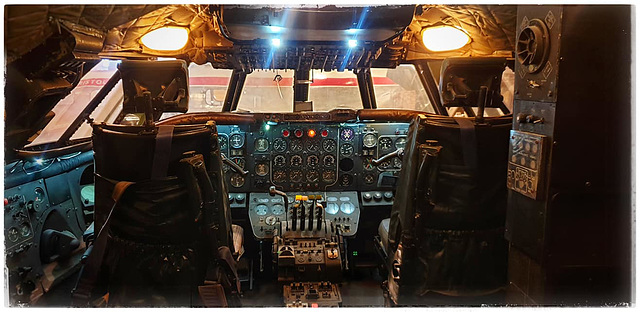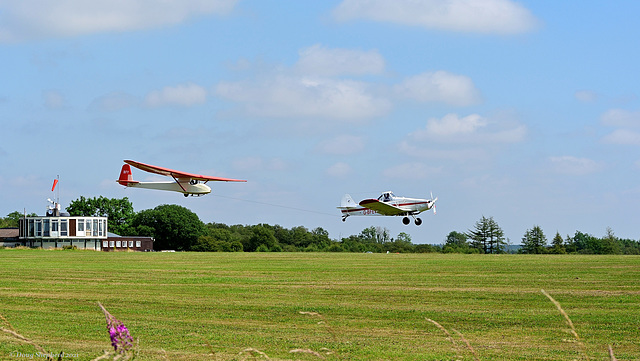
Aircraft
Concorde G-BOAF and a very happy grandson (Alexander)
Copyright: Andrew Shepherd
Concorde G-BOAF (216) was the last of the Concordes to be built, and the last aircraft to be built at Filton, the oldest aircraft factory in the world. Concorde 216 was really the last aeroplane built by the famous old Bristol Aircraft Company, even the Olympus 593 engines, the powerhouse of Concorde were Bristol engines, built and developed by the old company until the take over by Rolls-Royce.
Her first flight was on 20th April 1979 at Filton (Bristol), England. Concorde G-BOAF made the final fight of all the Concordes and closed the chapter on supersonic passenger travel, when she lifted off the London Heathrow runway for the final time and flew back to Filton, on November 26th 2003.
Hours Flown 18,257 Hrs
Landings 6,045
Supersonic Cycles 5,639
Bristol Britannia C1 'Rigel' XL657, RAF Gan, 1972 (Maldive Islands)
As a long range military transport aircraft the RAF Britannia C.Mk1 could lift eighteen and a half tons over 4,000+ miles, carrying freight only or up to 53 stretchers with medical personnel and life support equipment or a total 115 passengers … or a combination of all three. It was the RAF’s first strategic airlifter and a crucial component in the reshaping of Britain’s armed forces to meet the threats of the Cold War. Tasks included the rapid deployment worldwide of the then newly formed Army Strategic Reserve and also moving the V- Bomber Force detachments to the various dispersal airfields from their main bases in times of tension. The Britannia was flown jointly by 99 and 511 Squadrons, firstly at RAF Lyneham and later at Brize Norton. When the Britannia was withdrawn from service in 1975 as part of defence cuts, the Squadrons were stood down.
Bristol Britannia Flight Deck
Nicknamed the 'Whispering Giant', the Bristol Type 175 Britannia was a medium/long-range airliner built by the Bristol Aeroplane Company in 1952 to fly a number of air routes across the British Empire. Soon after entering production the engines proved unusually susceptible to icing, and two prototypes were lost while solutions to the problems were found. By the time it was cleared through testing the US-built jet airliners were about to enter service, and only eighty-five Britannias were built before production ended in 1960. Nevertheless the Britannia is often considered the high point in turboprop airliner design.
Displayed at Bristol Aerospace Museum , Filton, Bristol
06 May 2019
11 favorites
7 comments
Concorde G-BOAF
Copyright: Andrew Shepherd
Concorde G-BOAF (216) was the last of the Concordes to be built, and the last aircraft to be built at Filton, the oldest aircraft factory in the world. Concorde 216 was really the last aeroplane built by the famous old Bristol Aircraft Company, even the Olympus 593 engines, the powerhouse of Concorde were Bristol engines, built and developed by the old company until the take over by Rolls-Royce.
Her first flight was on 20th April 1979 at Filton (Bristol), England. Concorde G-BOAF made the final fight of all the Concordes and closed the chapter on supersonic passenger travel, when she lifted off the London Heathrow runway for the final time and flew back to Filton, on November 26th 2003.
Hours Flown 18,257 Hrs
Landings 6,045
Supersonic Cycles 5,639
Displayed at Bristol Aerospace Museum , Filton, Bristol
06 May 2019
12 favorites
2 comments
Bristol Britannia Flight Deck
Copyright: Andrew Shepherd
Nicknamed the 'Whispering Giant', the Bristol Type 175 Britannia was a medium/long-range airliner built by the Bristol Aeroplane Company in 1952 to fly a number of air routes across the British Empire. Soon after entering production the engines proved unusually susceptible to icing, and two prototypes were lost while solutions to the problems were found. By the time it was cleared through testing the US-built jet airliners were about to enter service, and only eighty-five Britannias were built before production ended in 1960. Nevertheless the Britannia is often considered the high point in turboprop airliner design.
Roulston Scar with haze over the Vale of York (1 x PiP)
Roulston Scar (also know as Sutton Bank) is a high point on the Hambleton Hills and the North Yorkshire Moors with extensive views over the Vale of York. It is the site of one of the most important prehistoric monuments in the region: a massive Iron Age hillfort, constructed around 400 BC.
Because it faces the prevailing westerly winds, Sutton Bank has been used for the sport of gliding since the early 1930s The Yorkshire Gliding Club opened in 1934 and is based at the top of the hill.
Tug launch of a glider approaching the cliff edge of Raulston Scar, indicated here by the tops of the shrubs.
Air tow at the Yorkshire Gliding Club - Sutton Bank
All is not what it seems to be!
This is a composite image with a 'fake' tow line. I was not able to get a decent shot with both aircraft in the frame, hence the above. The tug and the glider were not this close together during the tow. I estimated the length of the real tow line to be in the region of 150 ft/45 m, but I could of course be wrong.
I watched this glider take off, and having gained altitude, be released from the tug to do whatever it is glider pilots do. Ten minutes later, much to my surprise, I found it landing and coming to a halt close to me on the edge of the airfield. There appeared to be a discussion between the pilots as they sat in the cockpit for a couple of minutes, perhaps about the location of the landing. When the recovery vehicle arrived the post flight debrief was continued!
The glider under tow is a Slingsby T21B, a trainer, the first example of which flew in December 1947. Slingsby Sailplanes had factory in nearby Kirbymoorside which opened On the 4th September 1939. Slingsbys ceased all glider production in 1982.
The Landing & discussion (rather close to the edge of the airfield and the footpath)
Deplaneing
Post filght debrief (how did we get here?)
The Yorkshire Gliding Club operate from an airfield on Sutton Bank in the North York Moors National Park, England. The club formed in 1934 from an amalgamation of gliding concerns from the West Riding of Yorkshire and has been in existence for over 80 years and has had many famous fliers such as Nicholas Goodhart, Amy Johnson and Fred Slingsby.
The club's location, on top of Roulston Scar and Sutton Bank over the White Horse of Kilburn, and the sheer drop away of the cliff, has made it a notable aircraft launching point. It is the most popular gliding club in the north of England.
Jump to top
RSS feed- Latest items - Subscribe to the latest items added to this album
- ipernity © 2007-2025
- Help & Contact
|
Club news
|
About ipernity
|
History |
ipernity Club & Prices |
Guide of good conduct
Donate | Group guidelines | Privacy policy | Terms of use | Statutes | In memoria -
Facebook
X






